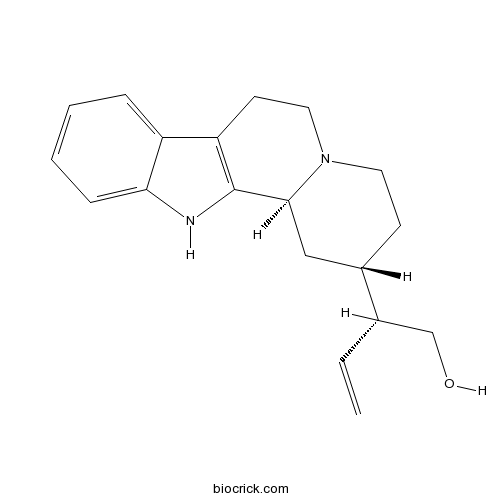AntirhineCAS# 16049-28-8 |

Quality Control & MSDS
3D structure
Package In Stock
Number of papers citing our products

| Cas No. | 16049-28-8 | SDF | Download SDF |
| PubChem ID | 5462421 | Appearance | Powder |
| Formula | C19H24N2O | M.Wt | 296.4 |
| Type of Compound | Alkaloids | Storage | Desiccate at -20°C |
| Solubility | Soluble in Chloroform,Dichloromethane,Ethyl Acetate,DMSO,Acetone,etc. | ||
| Chemical Name | (2R)-2-[(2S,12bS)-1,2,3,4,6,7,12,12b-octahydroindolo[2,3-a]quinolizin-2-yl]but-3-en-1-ol | ||
| SMILES | C=CC(CO)C1CCN2CCC3=C(C2C1)NC4=CC=CC=C34 | ||
| Standard InChIKey | RYMNVEAAYOFGCI-DEYYWGMASA-N | ||
| General tips | For obtaining a higher solubility , please warm the tube at 37 ℃ and shake it in the ultrasonic bath for a while.Stock solution can be stored below -20℃ for several months. We recommend that you prepare and use the solution on the same day. However, if the test schedule requires, the stock solutions can be prepared in advance, and the stock solution must be sealed and stored below -20℃. In general, the stock solution can be kept for several months. Before use, we recommend that you leave the vial at room temperature for at least an hour before opening it. |
||
| About Packaging | 1. The packaging of the product may be reversed during transportation, cause the high purity compounds to adhere to the neck or cap of the vial.Take the vail out of its packaging and shake gently until the compounds fall to the bottom of the vial. 2. For liquid products, please centrifuge at 500xg to gather the liquid to the bottom of the vial. 3. Try to avoid loss or contamination during the experiment. |
||
| Shipping Condition | Packaging according to customer requirements(5mg, 10mg, 20mg and more). Ship via FedEx, DHL, UPS, EMS or other couriers with RT, or blue ice upon request. | ||
| Description | Standard reference |
| Structure Identification | Phytochemistry.1974 Jul;13(7):1265-1267.Antirhine and antirhine metho-salt from the leaves of Strychnos camptoneura.[Reference: WebLink]
|

Antirhine Dilution Calculator

Antirhine Molarity Calculator
| 1 mg | 5 mg | 10 mg | 20 mg | 25 mg | |
| 1 mM | 3.3738 mL | 16.8691 mL | 33.7382 mL | 67.4764 mL | 84.3455 mL |
| 5 mM | 0.6748 mL | 3.3738 mL | 6.7476 mL | 13.4953 mL | 16.8691 mL |
| 10 mM | 0.3374 mL | 1.6869 mL | 3.3738 mL | 6.7476 mL | 8.4345 mL |
| 50 mM | 0.0675 mL | 0.3374 mL | 0.6748 mL | 1.3495 mL | 1.6869 mL |
| 100 mM | 0.0337 mL | 0.1687 mL | 0.3374 mL | 0.6748 mL | 0.8435 mL |
| * Note: If you are in the process of experiment, it's necessary to make the dilution ratios of the samples. The dilution data above is only for reference. Normally, it's can get a better solubility within lower of Concentrations. | |||||

Calcutta University

University of Minnesota

University of Maryland School of Medicine

University of Illinois at Chicago

The Ohio State University

University of Zurich

Harvard University

Colorado State University

Auburn University

Yale University

Worcester Polytechnic Institute

Washington State University

Stanford University

University of Leipzig

Universidade da Beira Interior

The Institute of Cancer Research

Heidelberg University

University of Amsterdam

University of Auckland

TsingHua University

The University of Michigan

Miami University

DRURY University

Jilin University

Fudan University

Wuhan University

Sun Yat-sen University

Universite de Paris

Deemed University

Auckland University

The University of Tokyo

Korea University
- THZ2
Catalog No.:BCC3986
CAS No.:1604810-84-5
- THZ1
Catalog No.:BCC4005
CAS No.:1604810-83-4
- 30-Oxopseudotaraxasterol
Catalog No.:BCN7135
CAS No.:160481-71-0
- 3',5,5',7-Tetrahydroxyflavanone
Catalog No.:BCN1710
CAS No.:160436-10-2
- X-NeuNAc
Catalog No.:BCC2063
CAS No.:160369-85-7
- Bisdehydroneotuberostemonine
Catalog No.:BCN7072
CAS No.:160333-27-7
- L-368,899 hydrochloride
Catalog No.:BCC7438
CAS No.:160312-62-9
- 8-Hydroxybergapten
Catalog No.:BCN2732
CAS No.:1603-47-0
- SB 205384
Catalog No.:BCC7095
CAS No.:160296-13-9
- 14-Deoxy-11-hydroxyandrographolide
Catalog No.:BCN4702
CAS No.:160242-09-1
- SR 11302
Catalog No.:BCC3607
CAS No.:160162-42-5
- BIM 23127
Catalog No.:BCC5822
CAS No.:160161-61-5
- Bisandrographolide A
Catalog No.:BCN4701
CAS No.:160498-00-0
- 12S-hydroxyandrographolide
Catalog No.:BCN4700
CAS No.:869593-50-0
- BW 723C86 hydrochloride
Catalog No.:BCC6915
CAS No.:160521-72-2
- 5,7,3',4'-Tetrahydroxy-3-methoxy-8-geranylflavone
Catalog No.:BCN6847
CAS No.:1605304-56-0
- Zarzissine
Catalog No.:BCN6456
CAS No.:160568-14-9
- DMP 543
Catalog No.:BCC7331
CAS No.:160588-45-4
- Villosin
Catalog No.:BCN1711
CAS No.:160598-92-5
- 1,4,6-Trihydroxy-5-methoxy-7-prenylxanthone
Catalog No.:BCN1548
CAS No.:160623-47-2
- 2,3-Dihydro-3alpha-methoxynimbolide
Catalog No.:BCN7093
CAS No.:1607828-35-2
- Ardisicrenoside B
Catalog No.:BCN8078
CAS No.:160791-12-8
- Indirubin-3'-oxime
Catalog No.:BCC7185
CAS No.:160807-49-8
- AMG319
Catalog No.:BCC6510
CAS No.:1608125-21-8
The isolation of Nb-methyl-antirhine, malindine and isomalindine from Strychnos usambarensis.[Pubmed:17340243]
Planta Med. 1984 Feb;50(1):27-30.
Three quaternary alkaloids have been isolated from root barks of STRYCHNOS USAMBARENSIS Gilg from Rwanda: malindine, isomalindine and Nb-methyl-Antirhine. The structure elucidation and the stereochemistry of the new isomalindine has been proposed based on its spectral data and their comparison with those of malindine, its isomer.


